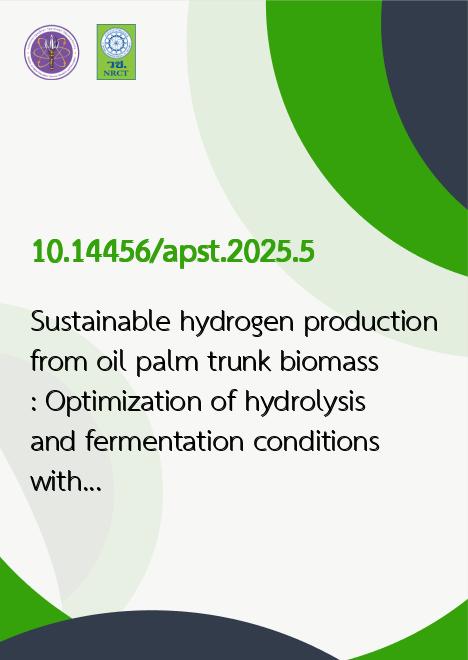
|
Sustainable hydrogen production from oil palm trunk biomass: Optimization of hydrolysis and fermentation conditions with Clostridium beijerinckii PS-3 |
|---|---|
| รหัสดีโอไอ | |
| Creator | Pongsak Noparat |
| Title | Sustainable hydrogen production from oil palm trunk biomass: Optimization of hydrolysis and fermentation conditions with Clostridium beijerinckii PS-3 |
| Contributor | Jiravut Seengenyoung |
| Publisher | Asia-Pacific Journal of Science and Technology |
| Publication Year | 2568 |
| Journal Title | Asia-Pacific Journal of Science and Technology |
| Journal Vol. | 30 |
| Journal No. | 1 |
| Page no. | 5 (10 pages) |
| Keyword | biofuel, oil palm trunk hydrolysate, Clostridium beijerinckii, renewable energy |
| URL Website | https://so01.tci-thaijo.org/index.php/APST/ |
| Website title | https://so01.tci-thaijo.org/index.php/APST/article/view/270280 |
| ISSN | 2539-6293 |
| Abstract | The study aimed to advance biohydrogen production by leveraging oil palm trunk (OPT) hydrolysate as a sustainable feedstock for Clostridium beijerinckii PS-3. Through a controlled hydrolysis process, OPT was treated with sulfuric acid (H₂SO₄) concentrations from 0.05% to 3.0% (v/v) over reaction times of 5 to 20 minutes at 121ºC. The optimal hydrolysis condition, determined to be 0.1% H₂SO₄ for 15 minutes, produced a hydrolysate rich in fermentable sugars, with a total concentration of 24.02 g/L—comprising 17.04 g/L xylose, 5.11 g/L glucose, 1.87 g/L arabinose, and 2.59 g/L acetic acid. To maximize hydrogen yield, response surface methodology (RSM) and central composite design (CCD) were employed, identifying peptone, iron, and nickel as critical elements influencing production efficiency. Optimal concentrations of 3.50 g/L peptone, 0.80 mM iron, and 0.80 mM nickel were predicted to yield a maximum of 2685 mL/L hydrogen. Experimental validation under refined conditions of 3.25 g/L peptone, 0.63 mM Fe²⁺, and 0.74 mM Ni²⁺, at an initial pH of 6.3 and 30ºC, surpassed predictions, achieving 2832 mL/L cumulative hydrogen and a yield of 236 mL H₂/g total sugar—an 11% increase over conventional media. Triplicate trials confirmed the consistency and robustness of OPT hydrolysate as a substrate for fermentative hydrogen production by C. beijerinckii PS-3. The substantial yield improvement illustrates the potential of OPT hydrolysate as a viable, low-cost resource for biohydrogen, emphasizing the importance of tailored hydrolysis and medium optimization in enhancing bioenergy production processes. Such advancements affirm the role of agricultural waste valorization in achieving economically feasible and environmentally sustainable biofuel solutions. |
